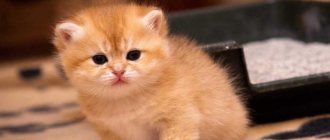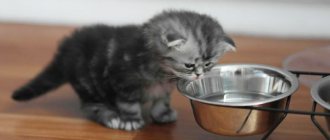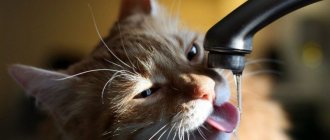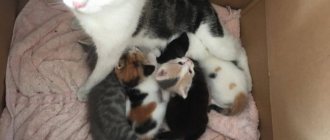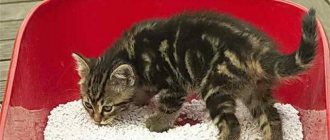How much water should a cat drink per day?
The average moisture requirement of mammals is about 5% of their live weight. This includes drinking water and taken with food. If there is neither one nor the other, body reserves are consumed: with the oxidation of 100 g of fat, an average of 106 g of water is formed. In hot weather the animal drinks more, in cool weather less.
If your cat is sick, water intake may decrease or increase. Therefore, you should not panic. If the cat does not lap up the water, then perhaps she is getting enough moisture from the food.
Liquid consumption rate
When feeding an animal with dry food, it is necessary to provide it with constant access to clean water. On average, a cat should drink about 100-150 ml per day, depending on the weight of the pet. Particularly obese cats need more fluid, kittens need less.
You can accurately calculate the amount of water based on the frequency of supply. On average, one part of dry food should be three parts of water per day. If, in addition to dry food, the animal consumes canned cat food, the amount of water may decrease, since such food is wet and covers half of the daily fluid intake.
You might be interested in: What to do if your cat has a bald spot?
Reasons why a cat doesn't drink water
All the reasons why a cat does not lap from a bowl are divided into physiological and pathological.
Physiological reasons
The cat does not lap from the bowl for the following reasons:
- Eating natural food or wet canned food. In the wild, there is enough water in the body of a mouse or bird. In the savannah, during the dry season, predators eat meat that contains enough moisture, and if hunting does not bring luck. They use up their own fat reserves.
- The bowl of water smells unpleasant. Instinct does not allow a cat to drink bad water. If the drinker is located next to a tray or feeder, it takes on the smell of excrement or fermented food. In the wild, it is not dirty water that poses a danger to a cat, but microscopic algae that multiply in it and release algatoxins.
- The cat doesn't like the bowl. Metal utensils rattle, plastic utensils absorb odors. Therefore, it is necessary to use ceramic or glass bowls.
Be sure to read:
Why does a crust appear on a cat's nose?
Pathological causes
Diseases that cause vomiting, swelling, inflammation of the mouth, paralysis, are accompanied by a refusal to drink. The cat doesn't drink not because he doesn't want to, but because he can't.
The gag reflex applies to everything that enters the stomach: food and water. This condition is called hydrophobia and hydrophobia. Associations with rabies should not be made.
There are many pathological conditions in which a cat refuses to drink. The most dangerous are panleukopenia or calcivirosis. But such diseases are typical for unvaccinated kittens and are distinguished by many other pathological symptoms.
Ways to increase interest in water
Try changing the bowl. For example, if you have a green plastic bowl, change it to a white ceramic or stainless steel one.
None Our regular viewer shares his experience of how he managed to interest the cat, and he began to drink more water.
Ksyusha Karapetyan: Thank you for the useful video, Sergey. Our sweet bun also didn't want to drink from the bowl. We cut a 5 liter plastic bottle and put water in it for him.
There are still no limits to happiness. The main thing is to change the water every day, otherwise for some reason he also wets his paws in it from time to time.
Add milk or broth to clean water. Many cats like the smell of milk. For an average 200-300 ml bowl, 1-2 ml of milk or broth is enough, and sometimes a few drops are enough. But such water needs to be changed more often, especially in summer, as it quickly deteriorates.
Open tap. The running stream of water from the tap attracts many cats, try it, maybe yours will like it too. Of course, this method has its drawbacks. The quality of tap water is often terrible, so you will have to install a filter. And also someone will need to open and close the tap, that is, you will be tortured by running to the kitchen.
Buy a special drinking fountain. Cat fountains are sold online or in pet stores. They are of different types. In the form of a geyser, when water rises from the bottom and flows down a smooth surface, or a constantly running stream of water or a small waterfall.
Choose any one you like, but take the one that is quieter. Some cats are frightened by the noise from the running pump and are afraid to approach the fountain, below is a comment on the topic.
Tori May: Thank you very much, Sergey. Our cat is not a fan of drinking, even in the heat. We are looking for different ways to give them something to drink and attract them to bowls and jars.
We noticed that he liked to drink from a tall ceramic cup, matte, white, filled to the brim. Cats are afraid of fountains because of the noise of the pump; you need to choose a model with a quiet, gurgling sound and adjustable water supply. Cats almost never refuse such models.
Forced drinking. Usually they use a syringe without a needle and carefully pour it into the mouth in small portions, as I show in the video below. But this method is used when other methods do not work, for example during illness.
[custom_ads_shortcode1]
The cat does not drink water, what should I do?
If the cat stops drinking from the bowl, it is necessary to assess his condition and analyze his diet. If the cat is given mushy natural food or wet canned food, enough moisture is supplied. However, some owners believe that the cat must drink and to do this they open the water tap or purchase a drinking fountain. Other felinologists consider tap water unsuitable for pets and purchase bottled water.
If the cat does not lap up water, then it is necessary to monitor its behavior. When a pet is depressed, its eyes are sunken, its fur is disheveled, its skin is flabby, it is necessary to force it to drink. You can draw water into a syringe without a needle and pour it into the mouth drop by drop. The animal may not like it.
Then they resort to an alternative option: saline or Ringer-Locke solution is injected under the skin. The latter remedy is preferable because it contains Potassium, Sodium and Calcium chlorides in the same proportion as blood serum. Glucose binds toxic substances. converts them into safe compounds that are eliminated in the urine.
Up to 150 ml of liquid can be administered per day. After the injection, bulges are formed, which decrease before the eyes. When the cat begins to lap on its own, parenteral administration of the electrolyte solution is stopped. If the animal's general condition does not improve, seek veterinary help.
Be sure to read:
A cat refuses to eat: reasons, why it’s dangerous, first aid, what to do, how to increase the animal’s appetite
How does water affect a cat’s body and the rate of its consumption?
If a cat does not consume water, then its body will respond by slowing down all processes, thickening the blood and lymph, and disrupting the water-salt balance, which, in turn, will lead to serious health problems and it is unknown how long it will live, since it quickly becomes dehydrated. will die.
Important! As for the rate of water consumption, according to veterinarians, a cat should drink water according to its weight.
For every kilogram of it there is from 20 to 40 ml of liquid. Usually, the question of why a cat doesn’t drink water is asked by owners who feed their pets canned food, as well as foods that contain a high percentage of moisture. The fact is that by consuming them, the cat needs to drink less, since it receives moisture from the food. When animals that like dry food need liquid intake much more. This is perhaps the most logical explanation why a cat does not drink water.
If we talk about why a cat drinks little water, then the reason lies in the low need for water laid down over centuries due to the fact that the ancient ancestors of cats lived in arid areas and over time adapted to drink less liquid. In addition, the cat has the ability to obtain moisture by concentrating its urine. In fact, it is normal for cats to drink little water in a healthy state, so asking why this happens shouldn't worry you. Especially if the animal receives wet food.
Cat refuses water after sterilization
After the operation, the animal recovers from anesthesia and does not eat or drink anything for the first day. On the second day, they begin to feed the pet a little. To prevent the cat from straining and the stitches from coming apart, they give watery food: it is more profitable to take dry food for sterilized cats and dilute it to a liquid state.
You will have to forget about natural nutrition, otherwise the cat will be at risk for obesity and urolithiasis. In this state, the pet will not lap until it is switched to a dry type of food.
Cat in the wild
Cats drink little and can go without water for a long time.
In fact, murkas are low-drinking animals, and there is no secret in this. Most cats are of desert origin, where there is a priori little water, so the body drew the moisture necessary for normal functioning from the food it caught: game, mammals, reptiles, etc.
Only occasionally, for example, during a period of drought or during a forced hunger strike, did wild predators drag themselves to a watering hole, where they replenished their reserves of necessary liquid. By the way, some representatives of the huge cat family do not drink water at all. Take, for example, the same dune cat or sand cat - the species is considered elusive, because it is simply impossible to meet them near the water.
Let's remember about lions. If possible, they drink every day, but they can easily survive without liquid for up to 5 days, and this will not particularly affect their health. Therefore, there is nothing surprising or extraordinary in the fact that domestic cats, direct descendants of wild cats, drink little - this unique property is inherent in them by nature.
[custom_ads_shortcode2]
What happens if a cat doesn’t drink water for a long time?
If a sick cat does not drink, a condition called dehydration or dehydration will occur. The load on the heart will increase, which will begin to pump viscous blood.
Be sure to read:
A cat sneezes: causes, symptoms, what to do, treatment methods, what should alert you
The conditions for the enzymes to work will be disrupted. The kidneys will stop filtering toxic substances. Conditions will arise for the formation of blood clots and blockage of blood vessels.
The following pathological symptoms are characteristic of dehydration:
- depressed state;
- the eyes are sunken;
- dry mucous membranes;
- When squeezed, the skin fold straightens out slowly.
Dehydration threatens the animal's life.
Why water is important for cats
Water is vital for any living creature. It performs important functions in the body:
- regulates body temperature;
- transports nutrients;
- necessary for digestion of food;
- helps remove toxins from the body;
- supports the functions of internal organs;
- ensures the functioning of enzymes;
- participates in the functioning of muscles, joints, eyes;
- maintains tissue elasticity.
Therefore, it is important to have enough of it in the diet. In animals that consume little fluid, concentrated urine is dark yellow in color with a pronounced odor. At the same time, they rarely go to the litter box. Constipation is also an indirect sign of insufficient fluid intake. This can contribute to the formation of sand and stones in the bladder. And also a lack of fluid can lead to weakening of the body, metabolic disorders and decreased immunity. It is necessary that your pet has unlimited access to water around the clock.
What kind of water should I drink?
To avoid health problems, it is not enough for an animal to consume a certain amount of liquid per day. Another important condition is that the water must be of high quality, which is why the owner needs to be very careful about its choice. For an animal to like water, it must be:
- fresh and clean (it is recommended to change the water every day);
- do not contain foreign odors;
- should be freely available.
If owners give their pet water from the tap, before pouring it into a bowl, the liquid must be filtered and allowed to steep for at least 5 hours. However, veterinarians categorically do not recommend using it, since running water contains many harmful impurities and components, including chlorine.
[custom_ads_shortcode2]
How to teach a kitten to drink?
There are many ways to teach a kitten to drink water from a bowl. The easiest way to do this is during an active pastime. During the game, the pet moves a lot and loses more moisture than in a calm state. Immediately after the game, the owner needs to bring a bowl to his face, so the chance of teaching the animal to drink cool water increases several times.
If the animal still refuses to drink, it can be forced to do so, for example, using a syringe filled with water. In addition, a small amount of liquid can be added to your pet's food so that he consumes it along with food. If the cat is very small, you can teach him to drink in the following ways:
- You can add a little milk to the food and gradually mix it with water. Kittens know what milk smells like and therefore rarely refuse it.
- You can place several bowls filled with clean water throughout the apartment. They should attract the kitten's attention, so it will be much easier to teach him to drink.
- Another effective way to teach a kitten to drink is by wetting its nose in water or milk. The owner just needs to wet his finger in water and wipe the animal’s nose with it several times. The cat will lick it by inertia, thereby getting used to the smell and taste of water.
If your pet is used to drinking from a tap and likes the sound of running water, you can purchase a special drinking fountain and install it in a convenient place.
Drinking fountain Note! It is strictly not recommended to place a bowl of water near a cup of food. This is due to the fact that the water must be perfectly clean and free of foreign odors, otherwise the animal may continue to refuse to drink.
[custom_ads_shortcode1]
The danger of fluid deficiency in the body
If a new family member does not drink water, most owners begin to sound the alarm, and for good reason. Veterinarians warn that refusing water can trigger the development of serious health problems, including urolithiasis. Also, with prolonged dehydration, the possibility of death cannot be ruled out.
A lack of fluid in the body always negatively affects the cat’s well-being and appearance. If there is not enough water, the animal becomes lethargic, and the coat loses its shine and thickness.
None With such feeding, the animal must drink a lot, otherwise there is a possibility of growth retardation and the occurrence of other undesirable pathologies, including disruption of the lymph structure and failure of water-salt metabolism.
[custom_ads_shortcode2]
How can you tell if your cat has enough water?
A kitten's body consists of approximately 80% water, and the functioning of all internal organs and systems depends on its content. Water deficiency not only leads to disruption of internal organs, but also interferes with the absorption of vitamins and beneficial microelements that come with food.
Water deficiency negatively affects the animal. To prevent health problems, you need to know how much water the animal should consume per day.
You can calculate the daily norm in this way - the weight of the animal must be multiplied by 0.03. The resulting value will be the amount of water needed per day. The conventional norm is 40 ml per 1 kg of weight. It is worth considering that the amount of water consumed per day also depends on the activity of the pet and the time of year.
[custom_ads_shortcode1]
